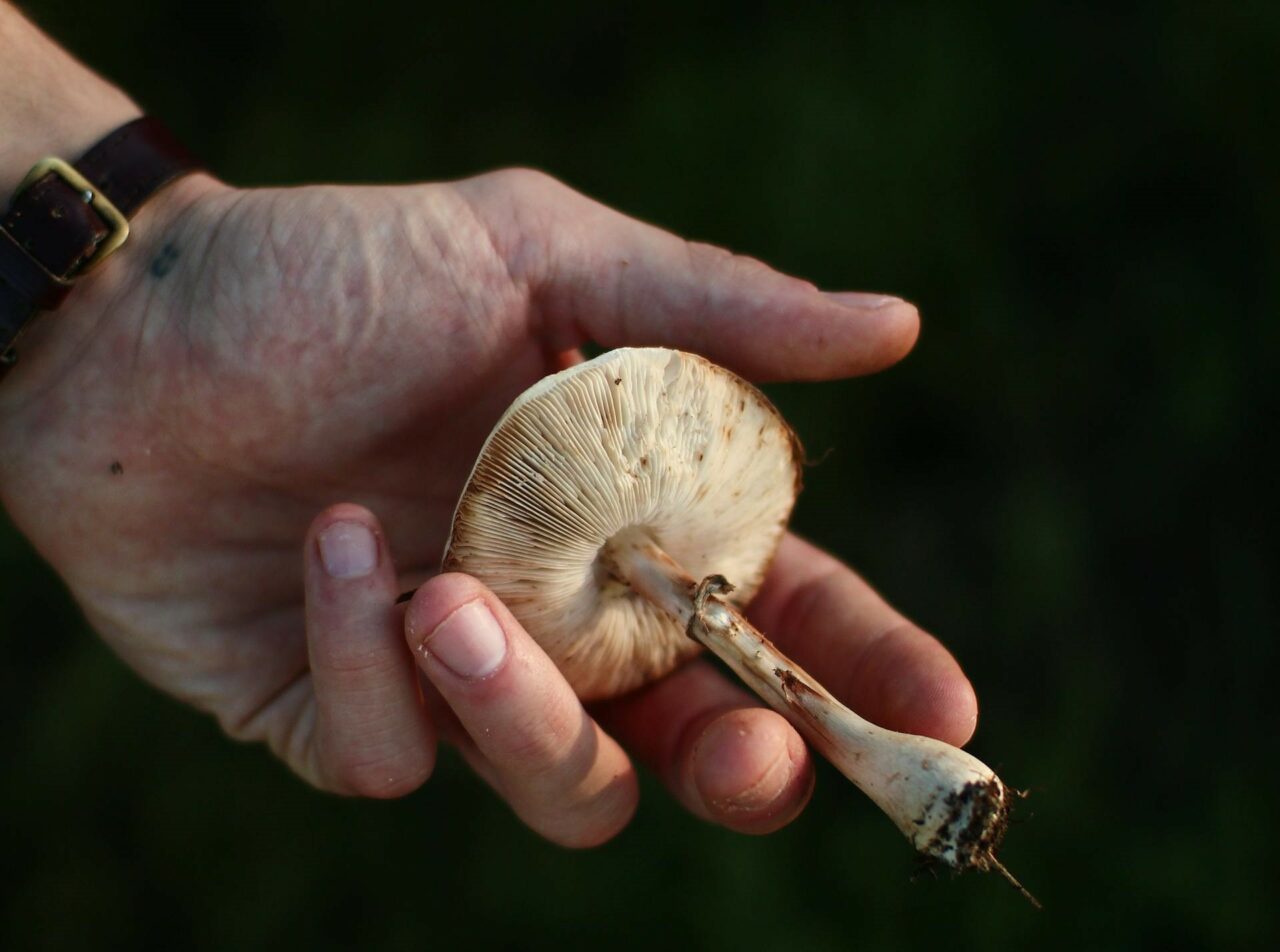Psilocybin mushrooms, a traditional psychedelic substance similar to LSD in its role as a serotonin 5-HT2A receptor agonist, are currently under investigation for their potential in psilocybin-assisted therapy. This therapy is being explored for a variety of mental health disorders, including significant emotional distress related to major depression, anxiety, cluster headaches, and migraines.
In order to understand how shrooms can alleviate these conditions, it’s essential to delve into their metabolism within the body. This knowledge empowers both researchers and users to comprehend how the active compound generates psychological and therapeutic effects. This article offers a basic overview of psilocybin’s pharmacology and pharmacokinetics.
[toc]
Key Takeaways:
- Half of ingested psychedelic fungi is absorbed and dispersed throughout the body.
- The compound in the fungi is dephosphorylated by the enzyme alkaline phosphatase, primarily within the liver.
- Nearly 3.4% of the compound is expelled in its original form within a 24-hour period, while most of it is excreted as a stable metabolite.
What is Pharmacokinetics?
Pharmacokinetics (PK) is the study of how substances, including drugs, are processed by the body once ingested. While similar, it is distinct from pharmacodynamics, which focuses on how a compound interacts with the body. PK explores four main areas: absorption, distribution, metabolism, and excretion (ADME).
Comprehending these processes enables medical professionals to prescribe the most effective medications with the least potential risk. It also allows them to customize treatments based on each patient’s distinctive physiology and lifestyle.
The Relevance of Pharmacokinetics to Psilocybin
Psilocybin and psilocin, the primary active components in certain magic mushroom species, have attracted significant attention from researchers and users. Pharmacokinetics analyses how the body processes these psilocybin-containing mushrooms, aiding our understanding of their potential therapeutic or recreational effects.
These compounds are referred to by a variety of names, such as “magic,” “psychedelic,” “medicinal,” or “sacred.” The fungi that contain these compounds are consumed, and the Mushroom species, their geographical origin, size, the conditions of their growth and storage, and their age can all cause significant shifts in their active component concentrations.
These magic mushrooms naturally occur in the wild. However, scientists have devised techniques to synthesize them in a laboratory setting. Both the naturally occurring and lab-grown versions exhibit minimal toxicity, with minor side effects such as nausea or vomiting occasionally reported.
Despite these minor physical side effects, the compounds found in these mushrooms have demonstrated potential therapeutic advantages due to their safety profile and non-addictive properties. These promising attributes have intrigued researchers, leading to studies on their use in psychotherapy, specifically for treating conditions like anxiety and depression.
The 4 Stages of Pharmacokinetics
Psilocybin, the compound present in these mushrooms, is inactive in its raw form and acts as a prodrug, converting into its active form, psilocin. Enzymes such as alkaline phosphatase facilitate this transformation, enabling psilocin to be absorbed and circulated throughout the body, reaching different tissues. However, after oral administration, detection of psilocybin in the circulatory system, feces, or urine is not possible.
Absorption
Absorption refers to the process through which the compound enters the bloodstream from the site of administration. It determines the speed and effectiveness of the compound reaching its target, such as the plasma. Oral administration is the most common route used. Inhalation has been tried but is not as efficient as oral consumption.
The process of absorption also encompasses the release of the compound from the dosage form during oral ingestion. Factors such as a delay in the throat or esophagus can affect this, potentially slowing down effects or causing discomfort. Once the compound arrives in the stomach, the acidic environment might begin to degrade it before it enters the bloodstream.
Studies on animals suggest that only around 50% of orally administered psychedelics are absorbed and distributed throughout the body.
Factors Impacting the Absorption Process
Several factors can influence the absorption process, leading to variations in the onset, intensity, and duration:
- Stomach Contents: Eating before administration can delay the process as it slows the onset of effects. Conversely, an empty stomach can facilitate quicker absorption.
- Body Fat: Substances can accumulate in fat tissue, potentially prolonging their effects.
- Age: Metabolic rates and body composition can vary with age.
- Zero-Order Kinetics: The substance is discarded at a constant rate, regardless of its concentration.
- First-Order Kinetics: The elimination rate is directly related to the concentration of the substance.
The psilocybin molecule’s phosphate group has strong polarity. When combined with the amine group’s positive charge, the molecule becomes zwitterionic, enhancing its water solubility compared to psilocin. In the absence of the phosphate group, psilocin becomes more lipid-soluble, metabolically available, and is more easily absorbed in the intestines.
class=”wp-block-heading”>DispersionDispersion pertains to how psilocin spreads throughout the body once it enters the bloodstream. Psilocin, being fat-soluble, can traverse the blood-brain barrier and access the central nervous system.
system.Various factors, such as the size, polarity, and protein-binding capability of the substance, along with an individual’s physical state—including hydration and body composition—significantly impact this process.
The goal is to achieve an effective concentration at the target location. To be effective, the substance must reach the intended area, as specified by the volume of dispersion, and remain unbound to proteins, allowing it to interact dynamically with its receptor.
What Affects the Dispersion Processes?
Several factors can influence the dispersion process:
Typically, the effects begin to manifest between 20-40 minutes after ingestion, peaking around 80-100 minutes. The effects of magic mushrooms usually persist for about 4-6 hours.
How Does Dispersion to the Brain Take Place?
An initial experimental study on two species showed that the order of its binding affinity is 5HT2A > 5HT1A > 5HT2B [23]. It also binds to dopamine D1, 5HT1E, 5HT5A, 5HT7, 5HT6, D3, 5HT2C, and 5HT1B receptors.
It acts as a partial agonist at the 5HT2A receptor, with efficacy around 40%. The psychedelic effects can be linked to its partial agonist activity at 5HT1A autoreceptors.
The enhancement of mood and psychotomimetic experiences may be attributed to the observed relationship between increased dopamine levels and feelings of depersonalization and euphoria. Hallucinogens work by modifying neurochemistry and receptor activity. It enhances 5HT2A agonist activity by elevating BDNF synthesis in the hippocampus, which encourages neurogenesis and reduces conditioned fear-related behaviours.
Elimination
Elimination refers to the process by which the The human body disposes of various substances primarily through the kidneys, but also through the lungs, skin, and gastrointestinal tract. Regarding the kidneys, a naturally occurring psychedelic substance gets filtered in the glomerulus or secreted in the tubules, and some reabsorption adds a layer of complexity to this process.
The main substance has a half-life of roughly 160 minutes, while psilocin’s half-life is about 50 minutes. Animal studies indicate that this substance is primarily expelled in the urine, accounting for approximately 65% within 8 hours of intake. After consumption, residue of the substance can be detected in smaller amounts in bile and feces.
In humans, about 3.4% of the substance is excreted in its original form within 24 hours, whereas most of it is eliminated as psilocin-O-glucuronide, a stable metabolite. Psilocin-O-glucuronide’s stability facilitates the detection of the substance in urine samples over a prolonged period.
Two primary methods of substance elimination are:
Most psychedelic substances adhere to the first-order kinetics approach, achieving constant concentrations after four to five half-lives. Complete elimination also occurs after about four to five half-lives.
Browse Our Assortment of Hallucinogenic Mushrooms
The metabolic process varies across different types of fungi. By shopping from reliable online vendors such as Strongest Magic Mushroom Strain Canada, you can evade the risk of accidentally ingesting harmful mushrooms. Some varieties, like Agaric mushrooms, can cause intense and undesirable effects. Therefore, it’s essential to procure magic mushrooms from trustworthy sources, rather than risky street vendors or wild foraging.
| Feature | Enigma | Full Moon Party | Gold Member | |
| Strain Type | Psilocybe Cubensis OMNI | Psilocybe cubensis (Thai Koh Samui) | Psilocybe cubensis | |
| Potency | Extremely high; 3.8% tryptamine content | Medium to high potency | High potency | |
| Visual Characteristics | Looks like a blob or | Resembles a cauliflower or brain | Classic cubensis look; medium in size | Bulky white stalks; caps in a hue of golden caramel; visible blue discoloration |
| Effects | Considered the most potent; induces intense reactions | Powerful cerebral high; late onset with vivid visuals | Intense visuals and elation |
Explore Psilocybin Mushroom Usage Online
Comprehending the pharmacokinetics of shrooms is crucial for medical practitioners, researchers, and consumers. Armed with this understanding, you can make well-informed decisions about dosage and timing, thus mitigating potential hazards.
Discover your perfect psychedelic experience at Strongest Magic Mushroom Strain Canada. Whether you’re after a serene journey or a deeper exploration, our diverse selection is designed to meet your unique requirements. Savor top-notch, secure, and quality-monitored shrooms, without worrying about dubious sources or poisonous mushrooms.
Experience the best magic mushrooms Canada has to offer, and take your psychedelic adventure to unparalleled heights.
Frequently Asked Questions
Can shrooms interact with other medications?
Our products can potentially interact with certain medications, particularly those affecting serotonin levels, such as SSRIs (Selective Serotonin Reuptake Inhibitors). SSRIs and SNRIs (Serotonin and Norepinephrine Reuptake Inhibitors) tend to reduce the effects, unlike non-serotonergic antidepressants. This decreased effect can linger for up to three months after stopping the antidepressant use.
Do all psychedelics have the same path as psilocybin?
Not really, each psychedelic substance has a unique structure that requires different metabolic processes to activate, and they bond to different receptors in the body. The administration method also impacts the absorption of each psychedelic. While the basic principles of absorption, metabolism, and distribution remain the same, the specific pathways and effects vary for each substance.
Does the form of the shroom affect the pharmacokinetics?
Indeed, the form (be it fresh, powdered, or dried mushrooms) can influence the absorption rate. For example, powdered forms might be absorbed quicker than whole dried ones due to faster dissolution.
Further Reading:





